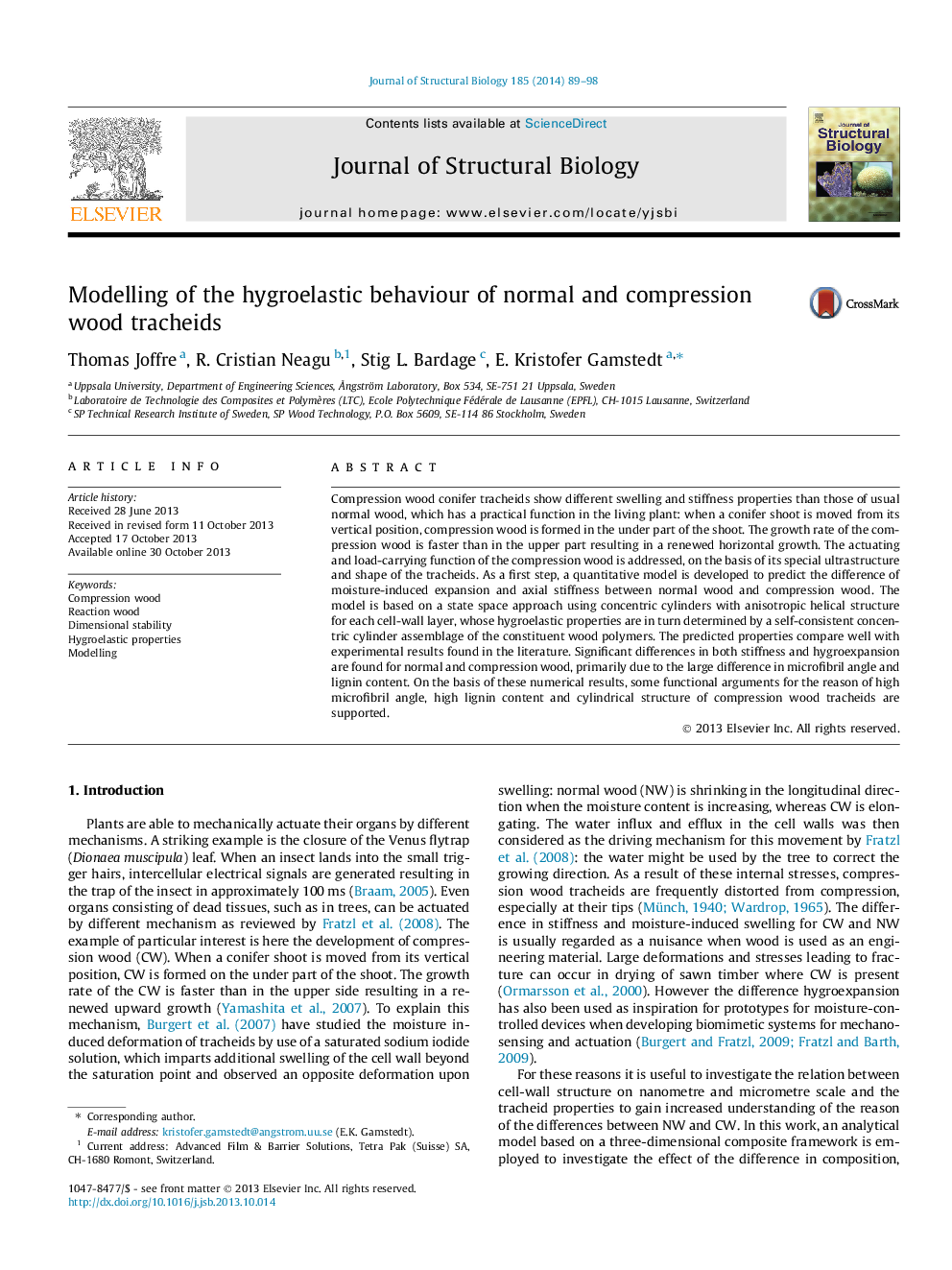| کد مقاله | کد نشریه | سال انتشار | مقاله انگلیسی | نسخه تمام متن |
|---|---|---|---|---|
| 5914201 | 1162724 | 2014 | 10 صفحه PDF | دانلود رایگان |
عنوان انگلیسی مقاله ISI
Modelling of the hygroelastic behaviour of normal and compression wood tracheids
ترجمه فارسی عنوان
مدل سازی رفتار هیپروالاستیک تراشه های چوب طبیعی و فشرده سازی
دانلود مقاله + سفارش ترجمه
دانلود مقاله ISI انگلیسی
رایگان برای ایرانیان
کلمات کلیدی
چوب فشرده، چوب واکنش ثبات ابعادی، خواص هیپرآپلاستی، مدل سازی،
ترجمه چکیده
تراشه های مخروطی فشرده چوب ویژگی های مختلف تورم و سختی را نسبت به چوب معمولی معمولی نشان می دهد که دارای عملکرد عملی در گیاه زنده است: هنگامی که یک ساقه مخروطی از موقعیت عمودی خود حرکت می کند، چوب فشرده سازی در زیر ساقه شکل می گیرد. نرخ رشد چوب فشرده سازی سریع تر از قسمت بالای آن است که باعث رشد فصلی جدید می شود. عملکرد عملکرد و حمل بار چوب چوب فشرده براساس خاصیت فوق العاده و شکل خاصی از تراشه ها مطرح می شود. به عنوان اولین قدم، یک مدل کمی برای پیش بینی تفاوت ظهور رطوبت و سختی محوری چوب معمولی و چوب فشرده سازی ایجاد شده است. این مدل بر اساس یک رویکرد فضایی دولتی با استفاده از سیلندرهای کنجکاوی با ساختار مارپیچی بی نظیر برای هر لایه دیواره سلولی است که خواص هیپروالاستیک آن به واسطه یک مجموعه سیلندر مرکزی مستقل از پلیمرهای تشکیل دهنده چوب تعیین می شود. خواص پیش بینی شده با نتایج تجربی موجود در ادبیات همخوانی دارد. تفاوت های قابل توجه در هر دو سفتی و افزایش انعطاف پذیری برای چوب نرمال و فشرده سازی، در درجه اول به دلیل تفاوت های زیادی در زاویه میکرو فایبریل و محتوای لیگنین است. بر اساس این نتایج عددی، برخی از استدلال های کاربردی به دلیل زاویه میکرو فایبریل بالا، مقدار لیگنین بالا و ساختار استوانه ای تراشه های چوب فشرده پشتیبانی می شود.
موضوعات مرتبط
علوم زیستی و بیوفناوری
بیوشیمی، ژنتیک و زیست شناسی مولکولی
زیست شناسی مولکولی
چکیده انگلیسی
Compression wood conifer tracheids show different swelling and stiffness properties than those of usual normal wood, which has a practical function in the living plant: when a conifer shoot is moved from its vertical position, compression wood is formed in the under part of the shoot. The growth rate of the compression wood is faster than in the upper part resulting in a renewed horizontal growth. The actuating and load-carrying function of the compression wood is addressed, on the basis of its special ultrastructure and shape of the tracheids. As a first step, a quantitative model is developed to predict the difference of moisture-induced expansion and axial stiffness between normal wood and compression wood. The model is based on a state space approach using concentric cylinders with anisotropic helical structure for each cell-wall layer, whose hygroelastic properties are in turn determined by a self-consistent concentric cylinder assemblage of the constituent wood polymers. The predicted properties compare well with experimental results found in the literature. Significant differences in both stiffness and hygroexpansion are found for normal and compression wood, primarily due to the large difference in microfibril angle and lignin content. On the basis of these numerical results, some functional arguments for the reason of high microfibril angle, high lignin content and cylindrical structure of compression wood tracheids are supported.
ناشر
Database: Elsevier - ScienceDirect (ساینس دایرکت)
Journal: Journal of Structural Biology - Volume 185, Issue 1, January 2014, Pages 89-98
Journal: Journal of Structural Biology - Volume 185, Issue 1, January 2014, Pages 89-98
نویسندگان
Thomas Joffre, R. Cristian Neagu, Stig L. Bardage, E. Kristofer Gamstedt,
